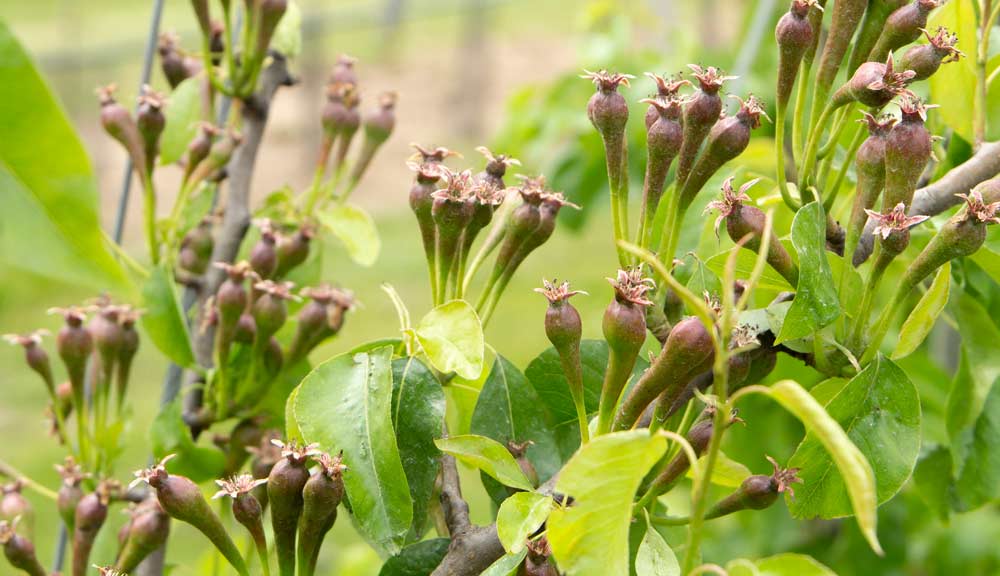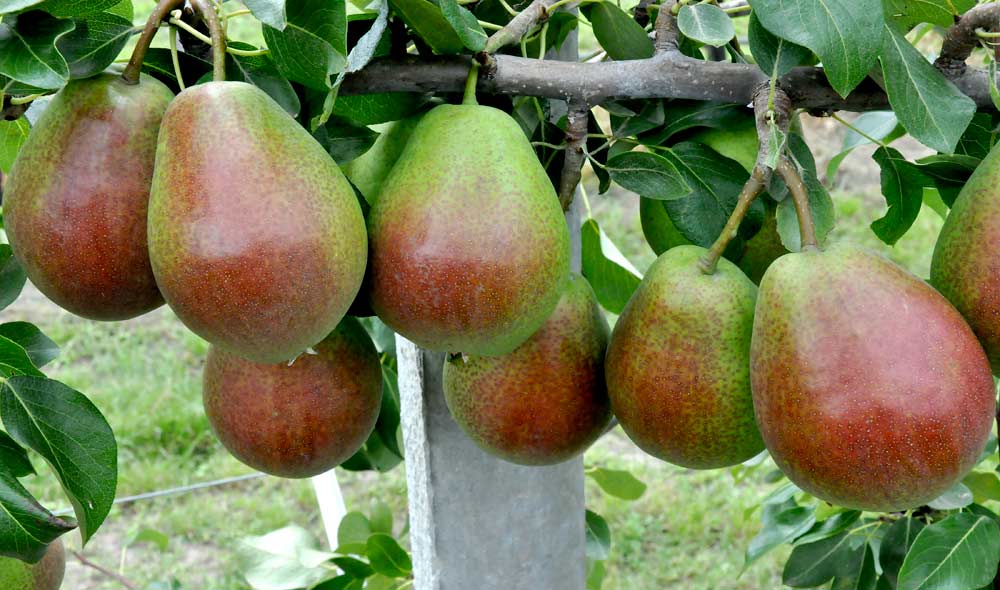
This orchard of Conference pears at pcfruit research station near Sint-Truiden, Belgium, survived the spring frost that decimated many apple and cherry orchards. (Shannon Dininny/Good Fruit Grower)
From a train speeding across the Belgian countryside, the bright green orchards and hillsides flashing by belie the damage of a prolonged cold April frost.
Fruit trees in many pockets of Europe were in full bloom when temperatures dropped as low as minus 6 degrees Celsius (21 degrees Fahrenheit).
In Belgium alone, growers estimated losses to upwards of three-fourths of the apple and cherry crops.
Pear trees there suffered, too, though not nearly as badly, and there’s a reason: A well-known variety that Belgian growers raced to plant on dwarfing rootstocks withstood the freeze.
The Conference pear has been around for many years, but its pairing with quince rootstocks pushed growers to plant it like never before over the past 20 years.
Those high-density plantings now account for more than half of all tree fruit acreage.
Today, Conference pears comprise more than 95 percent of Belgium’s 337,000 tons of pear production annually — surpassing apples by some 90,000 tons — and that’s expected to grow further as new orchards bear fruit.
In overall fruit production, Belgium is a bit player, but in pears, it ranks among the top producers in the European Union. And in the push to Conference, growers have been all-in.
“We easily have the capacity to go over 400,000 to 420,000 tons of pears when all the trees are in full production,” said Filip Lowette of BFV, a cooperative representing some 1,500 growers in Belgium’s fruit-growing region surrounding Sint-Truiden, a small agricultural city about 45 miles east of the capital of Brussels.
Sounds great, but there’s a downside. Belgium is a small country of only 11 million people who can’t possibly consume that many pears; 85 percent of its produce is exported. And one of its largest markets, Russia, banned imports of European and U.S. foods in 2014, leaving exporters scrambling to find new markets.
“It’s clear that Conference is getting difficult,” said Kris Wouters, 53, a fifth-generation grower who started an export company together with his brother Wim in part to better balance the farm’s financial interests.
“Growers who are just growers in Belgium today are all having financial problems,” he said. Those growers who have taken on side businesses, such as exporting fruit, making juice, opening inns or organizing trips for tourists, are surviving. “But those who are just really growing fruit, I’m really worried about the future for them.”
The new, old pear

Grower Kris Wouters poses with his daughter Silke in one of the family orchards in Rummen, Belgium in August. (Courtesy Kris Wouters)
The Conference pear is a green to bronzed, long and slim pear that becomes slightly yellow when ripening, with a sweet taste and juice texture. Picked in September, the pear has shown good storage properties and is available 10 months of the year, though it is prone to some russetting.
The dwarfing Quince MC and Quincy-Adams rootstocks that allow for high-density plantings are enabling much of the Conference growth, not just in Belgium, but also the Netherlands. The two countries trail only Italy in pear production in Europe.
In the 1990s, apples accounted for about 12,000 hectares of tree fruit in Belgium, while pears were planted on less than 5,000 hectares. This year, the country had just 6,200 hectares of apples and, for the first time, Conference pears topped 10,000.
U.S. growers, meanwhile, are in wait-and-see mode; American growers won’t do a lot of replanting until a rootstock hardy enough to withstand even colder temperatures is found.
There are other reasons Conference has taken hold in Belgium. The country has struggled to compete on labor costs with Poland, Europe’s leading apple producer, on production of Jonagold apples, Belgium’s key variety.
And the country sits too far north and lacks the warm climate and long growing season to grow many of the new apple varieties that consumers want, such as Cripps Pink or Fuji.
Belgian growers could have planted Galas, but the September harvest window aligned with Conference, which growers had already begun planting heavily, and would have further tightened the availability of labor, Wouters said.
Winding roads meander through the rolling hills of Eastern Belgium’s fruit country, in some places too narrow for two cars to pass through, then widening again as they reach a rural village marked by a church steeple and a smattering of homes and businesses. Solar panels line the roofs of many, and wind turbines dot the landscape.
Wouters farms on 60 hectares in the community of Rummen, two-thirds in pears. He’s had good luck with Conference, mostly on Quince C and Quince Adams rootstocks. Older trees are in a spindle system, while newer plantings average three leaders, each 50 centimeters apart, in 3.5-by-1.5-meter spacing.
But he remains concerned. “We are a little bit worried that we are going to get an overproduction. We had very good years with Conference pears, but now, since the Russian ban, we have a lot of difficulties selling the pears for a reasonable price.”
Wouters’ export company also exports about 30,000 tons of pears each year, but he too sees the need for other markets and new varieties.
He continues to gradually convert his remaining 20 hectares of Jonagold apples, with 8 hectares scheduled to be pulled this winter.
However, his target isn’t Conference. Rather, Wouters intends to plant more Celina pears, sold under the brand QTee.

Celina pears, sold under the Brand QTee, hang from a tree in an orchard owned by Kris Wouters in Rummen, Belgium. (Courtesy of Kris Wouters)
Celina is a red blush variety with an earlier harvest date and is not prone to russetting.
Wouters already has 12 hectares of Celina, with the oldest trees now 6 years old. He used Quince C rootstocks on very good virgin soil and Quince Adams rootstocks on replant sites.
He’s among a group of about 25 Belgian growers who have planted it, finding the variety productive and easy to grow. Most are planted as small, single trees, at 3.5-by-1 meter or 3.5-by-1.25 meter spacing, to allow as much fruit as possible to hang in the sunlight to color.
Wouters likened the pear to the Forelle variety from South Africa — a key, he said, since that country’s pears are out of the market by the time Celina would be harvested in the Northern Hemisphere.
In the fourth-leaf, Celina produces up to 50 tons per hectare, compared to his average of between 55 and 60 tons per hectare for Conference.
“The new variety is competitive. If you call me back in two or three years, when we have older trees, maybe I will tell you we are also growing 55 to 60 tons,” he said. “Right now, we just want to have a good quality pear, because when people buy a new variety for the first time, you don’t get a second chance.”
Meanwhile, exporters there continue to seek out new markets for Conference, with some help from the Belgian government and the European Union, and they’re finding footholds in previously untested markets.
Belgium was the first country allowed to export pears to mainland China, conducting in-store tastings and other promotional events to educate consumers about the variety.
Now, the industry is taking similar tactics in Malaysia, Singapore and India and is working to gain access to the U.S. market.
Next stops: Canada, Mexico and Brazil, Lowette told pear growers at the 10th annual Interpera conference in Wenatchee, Washington, in June.
Belgium has had to be more aggressive in other markets around the world, so now it just seems natural, though unfortunate, that growers there are now targeting Canada and Mexico, the top U.S. markets, said Kevin Moffitt, president and CEO of Pear Bureau Northwest, the nonprofit marketing arm for Washington and Oregon pears.
Belgium and The Netherlands continue to plant pears, and their production continues to increase, and without the Russian market, growers have to find homes for those crops, he said.
“Growing consumption is a slower process than putting fruit into a market,” he said. “And if they start putting more fruit into Canada or Mexico, or even the U.S., it will affect our market share. It will be small initially, but over the medium and long term, it’s something we will have to keep an eye on — and we are keeping an eye on it.”
Will it all be enough for pear growers in Belgium to survive?
Wouters’ 27-year-old daughter, Silke, has joined him on the farm, but he said he sees other farmers closing up shop in a region that is perhaps less lucky when it comes to climate.
“Now growers are really having problems and having to sell farms that have belonged in their families for maybe 100 years,” he said. “There are not a lot of young growers who want to start a fruit farm and follow their fathers onto the farm.
“As a grower community, we always say Europe makes economic war with Russia, and pears are the weapons,” he said. •
– by Shannon Dininny






Can someone tell me please why the Organic pear i bought in the supermarket has a stone instead of a pip?!!